A beginner's guide to Bhutan
Mountain Kingdoms have been organising cultural tours, walking holidays and trekking adventures to the Thunder Dragon Kingdom for more than 35 years, so we know this unique country inside out.
As Bhutan small group and tailor made travel experts, we’ve pooled our knowledge to put together this beginner’s guide which we hope will shed some light on the most intriguing of Himalayan nations.
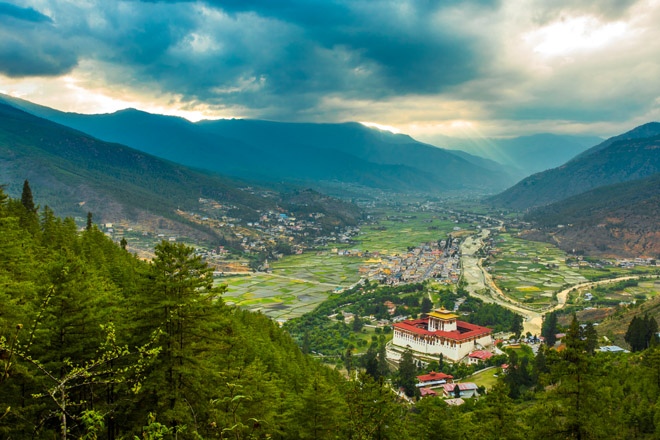
Paro - The starting point for most visitors to Bhutan
How do I get there?
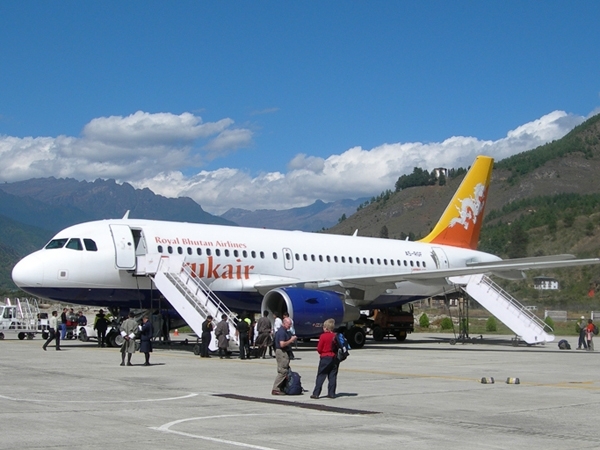
Druk Air flight at Paro airport - courtesy R Mellings
Part of the Himalaya, Bhutan is a small country sandwiched between India and Tibet, just east of Nepal and north of Bangladesh. Tourists have only been able to visit for 50 years. Tourism was officially prohibited until 1974, when the Government decided to open its isolated country to travellers in an effort to raise revenue and promote Bhutanese culture. Their philosophy of low volume, high value tourism and the implementation of a daily 'tourist tax' - the Sustainable Development Fee (SDF), has meant that it has remained a rather exclusive tourist destination, although visitor numbers are not actually restricted.
To reach Bhutan there are regular flights from Kathmandu, Delhi, Bangkok or Singapore – you cannot fly direct from the UK. Alternatively, if you are visiting Eastern Bhutan you can drive there from India via the border crossing at Samdrup Jonkhar.
When is the best time to visit?
Jacaranda trees in blossom at Punakha Dzong - courtesy of B Stones
Spring and autumn are considered the best time to visit Bhutan when the weather is generally warm and dry, the trails are open and the valleys are lush and verdant.
If you are trekking, October and early November provide the best window with frequent blue skies and dazzling views with temperatures of up to 20 degrees. March and April are also prime months to trek, suiting those who enjoy rhododendrons and other Himalayan flora.
If you are travelling to Bhutan on a walking holiday or cultural tour, you can even visit in the winter months. In fact, as long as you avoid the monsoon months in the summer, there will always be something exciting to see and do.
If you want to include time at a festival, then this will also be an important consideration of when you travel.
Which festivals should I see?
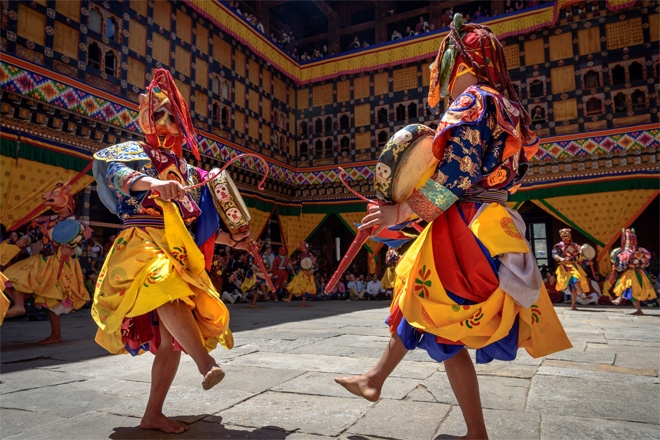
Dancers at the Paro Tsechu
Another thing to keep in mind when planning a holiday in Bhutan is of course the festivals. Known locally as tsechus, no holiday to the Thunder Dragon Kingdom would be complete without a visit to one.
Festivals in Bhutan perfectly encapsulate the exotic, other worldly culture, serving as both a sacred and social celebration. Thimphu Tsechu in the autumn and Paro in the spring are the most popular festivals due to their grand scale. Both are of great religious significance, celebrated through music and vibrant masked dances. If you prefer smaller crowds, there are many small local festivals that offer a real insight into the Bhutanese 'at play'. The Black-necked Crane Festival, celebrating the arrival of this endangered bird through song, dance and theatrical performance, is another great spectacle. All departures of our Definitive Cultural Tour of Bhutan and Gentle Walking Holiday Bhutan are timed to include a festival visit.
What’s the accommodation like in Bhutan?
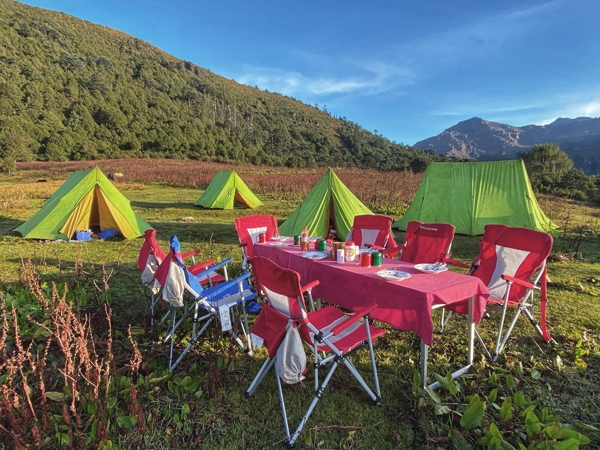
Camping on the Druk Path - courtesy of I Wilding
On our cultural tours or walking holidays in Bhutan you’ll be staying in good standard tourist hotels with rustic charm and modern amenities. If you fancy travelling in style there are now several premium quality hotels in Bhutan that offer real indulgence and the highest standards of service and facilities – we can include some of these hotels on a tailor made holiday.
For a more unusual experience our Hidden Valleys of Bhutan holiday includes several nights staying in a farmhouse homestay where you’ll experience the lives of the local people, and gain an insider’s view of Bhutanese culture.
And for the trekkers you’ll be sleeping under the stars in the wonderful Himalayan mountains and countryside, enjoying a first-rate camping service with full porterage, great food and top quality equipment.
What are the key cultural attractions?
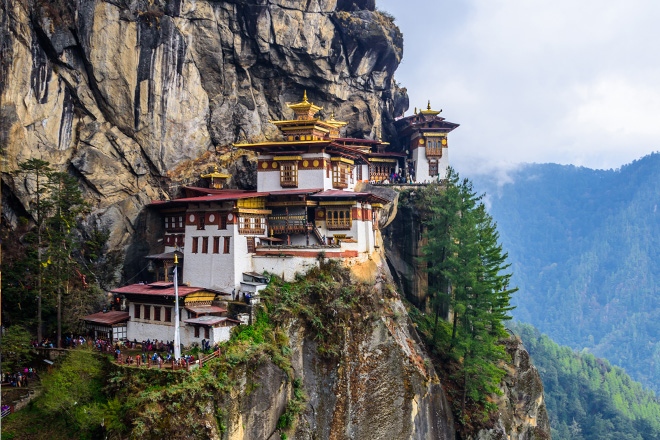
Taktsang Monastery - the Tiger's Nest
Tiger’s Nest Monastery should of course be at the top of your list of must see attractions. Perched dramatically on a cliff above the Paro Valley this very photogenic attraction has genuine wow factor. Bhutan is renowned for its impressive dzongs - these unique, and often ancient buildings act as both fortresses and administrative centre. With a dzong in every town you’ll be sure to visit at least one during your trip. All are spectacular buildings but the one that really stands out is Punakha dzong. Situated photogenically at the confluence of two rivers, its steep white walls topped with red and gold roofs and embellished with ornately carved wooden windows makes for a magnificent sight. In the springtime, the purple-blossomed jacaranda trees around the dzong make it even more Insta-worthy!
The capital of Bhutan, Thimphu, has many attractions to entertain and inform tourists, including the Tashichhodzong (the main government buildings), the Textile Museum, the late King's Memorial Chorten and the School of Painting to name but a few. There is also a fascinating riverside market full of local produce where you can pick up a great souvenir. On the high road between Thimphu and Punakha is one of Bhutan’s most scenic viewpoints, the Dochu La Pass. Marked by 108 memorial chortens, the 10,000ft high pass offers a stunning 360 degree panoramic view of the Himalayan mountain range including Gangkar Punsum – Bhutan’s highest peak at 7,550m/24,770ft. The Chele La Pass between Paro and Haa offers similarly stunning views on a clear day.
What’s the food like?
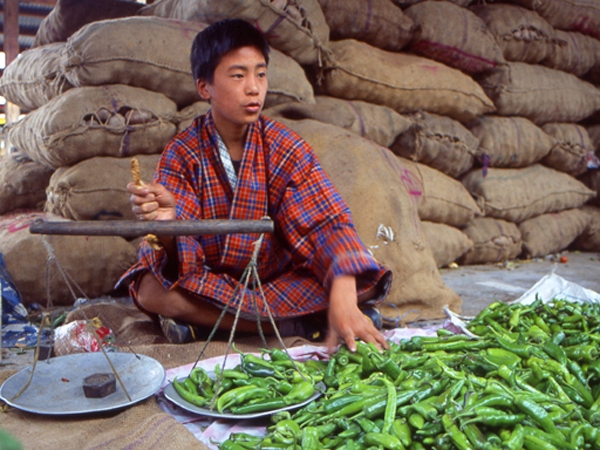
Selling chillis at Thimphu Market
Just like the country itself, the local cuisine of Bhutan has maintained a unique character, influenced somewhat by its neighbours, China, Tibet, and India. Overall, dishes are 'drier' than Chinese or Indian food and spicier than Tibetan. The most traditional meal you’ll find is Ema Datshi, a curry traditionally made from chili peppers and yak's cheese which packs a hefty punch in the spice department! Markets are a great place to see Bhutan's wealth of natural produce.
There are plenty of options for vegetarians but, despite being a Buddhist country many people still eat meat. However, the government does not allow the killing of animals for consumption so all their meat is imported from neighbouring countries, mainly India.
Is it good for walkers and seasoned trekkers?
Gentle walking
Bhutan is an absolute haven for walking or trekking enthusiasts with so much to see: towering peaks, picturesque valleys, attractive villages and spectacular dzongs. A walking holiday such as our Gentle Walking Bhutan, is the ideal introduction to all the premier sights of the Thunder Dragon Kingdom. But Dzongs and Tsechus are just the starting point of its attraction. As the roads and tour buses disappear you reach an untouched mountainous wilderness accessible only through trekking. There really is a trek for everyone from moderate all-rounders with superb scenery and cultural highlights such as the 5-day Druk Path Trek, to more challenging, high mountain adventures like the Lingshi Laya trek. The kingdom has a new long-distance trail which traverses the entire country from west to east. It's called the Trans Bhutan Trail and its total length is 250 miles. Too long? If you just want a taste of the trail, our Trans Bhutan Trail - Western Highlights includes all the best bits in just a couple of weeks.
The most epic adventure though is the Lunana Snowman Trek - a 28 day Himalayan classic that traverses the northern border entering the most wild and remote parts of Bhutan that very few local people. let alone visitors, are ever privileged to see.
What birds & wildlife can I expect to see?
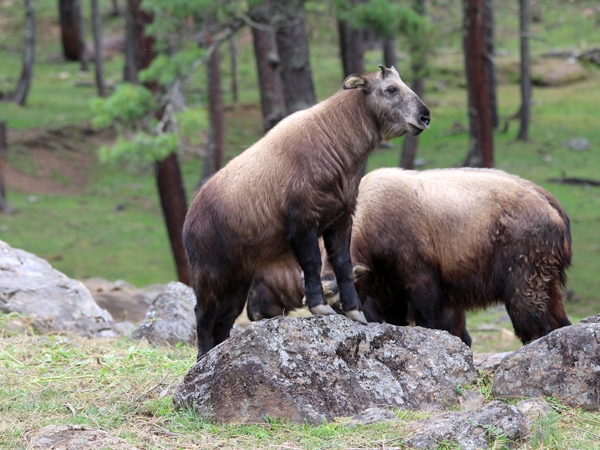
Takin
Bhutan's commitment to protecting its natural environment means that is has an immense variety of birds and wildlife. It is home to some rare creatures such as blue sheep, golden monkeys, clouded leopards, yaks and a myriad of exotic birds! One very unusual Bhutanese beast is the takin - Bhutan's national animal, a rather strange creature with the features of a goat, a cow and a moose combined. The best place to see them is in the Motithang Takin Reserve near Thimphu. During the winter months you can also see the revered Black-necked crane, a whitish-grey medium sized crane, with a black head, red crown patch and black upper neck and legs - they are considered sacred by the Bhutanese people. The cranes over-winter in Bhutan from Tibet and their annual arrival to the Gangtey Valley is heralded by celebrations and a special Black-necked Crane tsechu.
Traditions, Myths & legends?
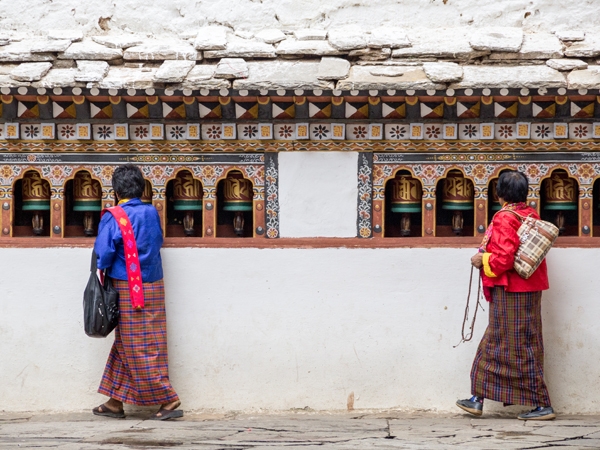
Prayer wheels
Although Bhutan has embraced many aspects of modern-day life including TVs and mobile phones, it is still a very traditional society. You will see that the Bhutanese people wear their traditional dress, they use time-honoured methods to farm and produce crafts and they incorporate the rituals and practices of Tibetan Buddhism into their everyday lives.
A place shrouded in mystery, Bhutan holds many supernatural tales, myths and legends – often connected to mountains, lakes and other natural features. In fact all mountains in Bhutan are considered sacred and it is forbidden to climb them. This is why Gangkar Punsum remains the highest unclimbed mountain in the world.
As you travel around Bhutan you can't but help notice the many phallus symbols painted on traditional houses and even sold as souvenirs. The use of the symbol is historically connected to the many legends surrounding Drukpa Kunley 'the Divine Madman', but today they are more generally considered a means to ward off evil spirits as well as a sign of good luck and fertility.
The people of Bhutan also believe in the yeti, or the migoi as it is locally known. There are many myths and legends about this very elusive creature. It tends not to frequent the more popular areas of western Bhutan – more likely to encounter signs of a yeti in Eastern Bhutan. There’s even a Migoi National Park in the far east of Bhutan – an area preserved for yetis to run wild! The Rodang La, also in the east, is known as a bit of a yeti ‘hot spot’. The locals have many tales to tell of strange noises and mysterious sightings. Even if you don’t see a yeti here you may well hear one whistling, you should also be on the lookout for unusual footprints as folklore has it that the migoi has the unique ability to walk backwards!
Find out more...
So that's our beginners guide to Bhutan, if you’d like experience this truly unmissable destination for yourself then take a look at our treks, cultural tours and walking holidays here and find an adventure that’s right for you. If you would like to discuss your plans or have any questions about travelling to the Thunder Dragon Kingdom then just speak to one our Bhutan experts who know the country inside out.